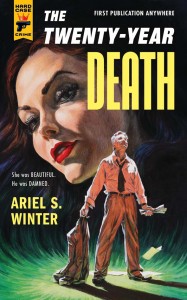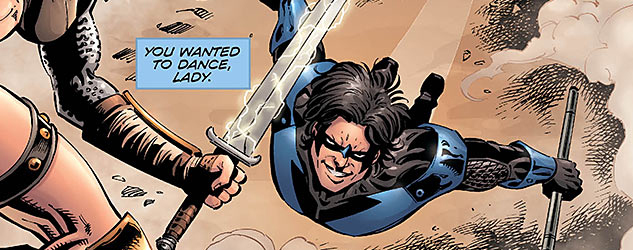 Ariel S. Winter might not be a big name in noir and literature. Or at least not yet. Bookseller turned novelist Winter’s newest book, The Twenty-Year Death, is a well-crafted novel that pays tribute to 30s, 40’s, and 50s noir in not one but three books tied together. Ariel S. Winter has also written One of a Kind for children, and blogs We Too Were Children, Mr. Barrie, a site that discusses twentieth century children’s literature that is currently out of print.
Ariel S. Winter might not be a big name in noir and literature. Or at least not yet. Bookseller turned novelist Winter’s newest book, The Twenty-Year Death, is a well-crafted novel that pays tribute to 30s, 40’s, and 50s noir in not one but three books tied together. Ariel S. Winter has also written One of a Kind for children, and blogs We Too Were Children, Mr. Barrie, a site that discusses twentieth century children’s literature that is currently out of print.
ComicAttack: You said that The Twenty-Year Death was meant to be one novel, and that Malniveau Prison pre-publication was different from the one in The Twenty-Year Death. What were the main differences between them?
Ariel S. Winter: So the original novel was to be a frame narrative about a first person narrator reading lots of different books. The idea was that I would present each of those books in full, so we got to read the books the narrator was reading. Malniveau was written for that. It was less than half its current length, about 130 pages, and it ended with a traditional parlor room style ending where Pelleter gathered all of the participants and explained exactly what had happened. When I initially decided to pull Malniveau out of the frame narrative novel, I was at that time thinking of it as a stand alone book. I doubled the length, introduced action at the end, and was going to try to sell it like that. But somehow The Twenty-Year Death came to me, and it became book one of the much larger novel.
CA: Did you plot out most of The Twenty-Year Death or did it simply happen?
ASW: It just happened. Once it was all done, I might have tweaked the chronology in a sections, but the initial plotting came in the writing.
CA: The Falling Star certainly had a lot of details about the City of Angels. Did you ever visit/live in LA, or did you simply do some heavy research?
ASW: I’ve been to L.A., but not enough to have any real sense of the city. Most of what I knew about Hollywood I knew by reading Chandler and Fitzgerald, having done almost no research beyond that, except into the history of horse racing in L.A. One of the reasons the city is actually San Angelino instead of Los Angeles is so that I could make mistakes and not worry about them since the city was made up. The other reason was that Chandler did actually call the city S.A. in his early stories, so there was precedent to do so myself.
CA: Are you going to return to noir anytime soon?
ASW: I’m definitely not done with noir, but it’s not what I’m going to be working on next. Right now I’m rewriting an earlier novel, which is not a genre novel at all. Hopefully that will be the next book to get published. And I have interest in working in some of the other genres, in particular fantasy, so it might be awhile until I get back to the mystery. But I will get back to it, I’m sure.
CA: Would you consider revisiting characters such as Dennis Foster?
ASW: As of right now, I don’t think I would revisit Pelleter or Foster. The idea for The Twenty-Year Death was, what would a mystery series look like if the character we followed from book to book was one other than the detective? So the point of the book was to use the detectives only once. If I went on to use them again, it would go counter to the intention.
CA: The Twenty-Year Death has Simenon, Chandler, and Thompson listed as primary influences. Are there any influences you have that might completely surprise us?
ASW: The biggest one that people might not expect is comic books, especially Batman. Batman is a hard boiled detective, after all, and while I already had started to read hard boiled detectives before I started reading comics, Batman was such a huge part of my childhood (and still today) that his influence can not be discounted. Otherwise, I don’t think there would be any surprise that I also read Hammett, that Fitzgerald and Faulkner are favorites, and even that my modern favorites are Michael Chabon, Jonathan Lethem, Ian McEwan, David Mitchell, all people who play with genre and mix it up.
CA: You’ve worked with illustrator David Hitch for the children’s book One of a Kind. Does that mean you have any plans on perhaps dabbling in comic books someday?
ASW: I would love to work in comics. I’ve been a diehard fanboy all of my life, and watching a writer like Scott Snyder cross from prose fiction into comics has really made me question what direction I want to go. Ideally, I’ll get the chance to do both. I have an idea for a mini-series that my agent is going to pitch to the people who own the characters in the next week or two, so maybe the dream will come true sooner rather than later.
CA: Are your own children your biggest fans of One of a Kind (as Shem Rosenkrantz once desired from his own son)?
ASW: Yes. My daughter is four, and she’s beyond proud of me. When One of a Kind first came in the mail, we read it over and over. When people come over to the house, she pulls it off the shelf and asks, “Do you want to see my Daddy’s book?” I have postcards that I give out with the cover of One of a Kind on one side and The Twenty-Year Death on the other, and she pulls them out of my pocket and hands them out all of the time. It’s interesting to see such a young child show so much pride in someone else’s achievements. It’s not something you expect of pre-schoolers.
CA: Do you plan on releasing And the Other Permanent Things?
ASW: Yes. That’s the book I mentioned earlier. There’s been some serious interest at a couple of publishers, but they’d like me to do some rewrites before they make an offer. I’m always hesitant to do that, since you hear so many stories of people putting in a lot of work to address a publishers’ concerns, and then the publisher still doesn’t buy the book. Right now, however, I’m leaning towards doing the rewrites to get And Other Permanent Things out there.
CA: What is it like to be a bookseller, and did it prepare you in any way for becoming a writer?
ASW: I saw someone say recently that all authors should be required to work at a small independent bookstore for a few months, and I’d agree. Part of it is just learning the business. Authors would come in when I was working as a bookseller, and ask, how do I get my book in your store. And they knew nothing about Baker and Taylor or Ingram, about sales reps, advance reader copies, all the things that get books into stores. Also, to manage expectations. I know about unsold books getting returned to the publishers and remaindered, and that no one shows up to a reading by a no name author. And, of course, I was exposed to many more books than I would have been otherwise, which is essential as a writer, since reading is such an integral part of writing.
Andrew Hudson
ahudson@comicattack.net
@Hudsonian




Good information here. I love how anything can be googled, and there’s the information!